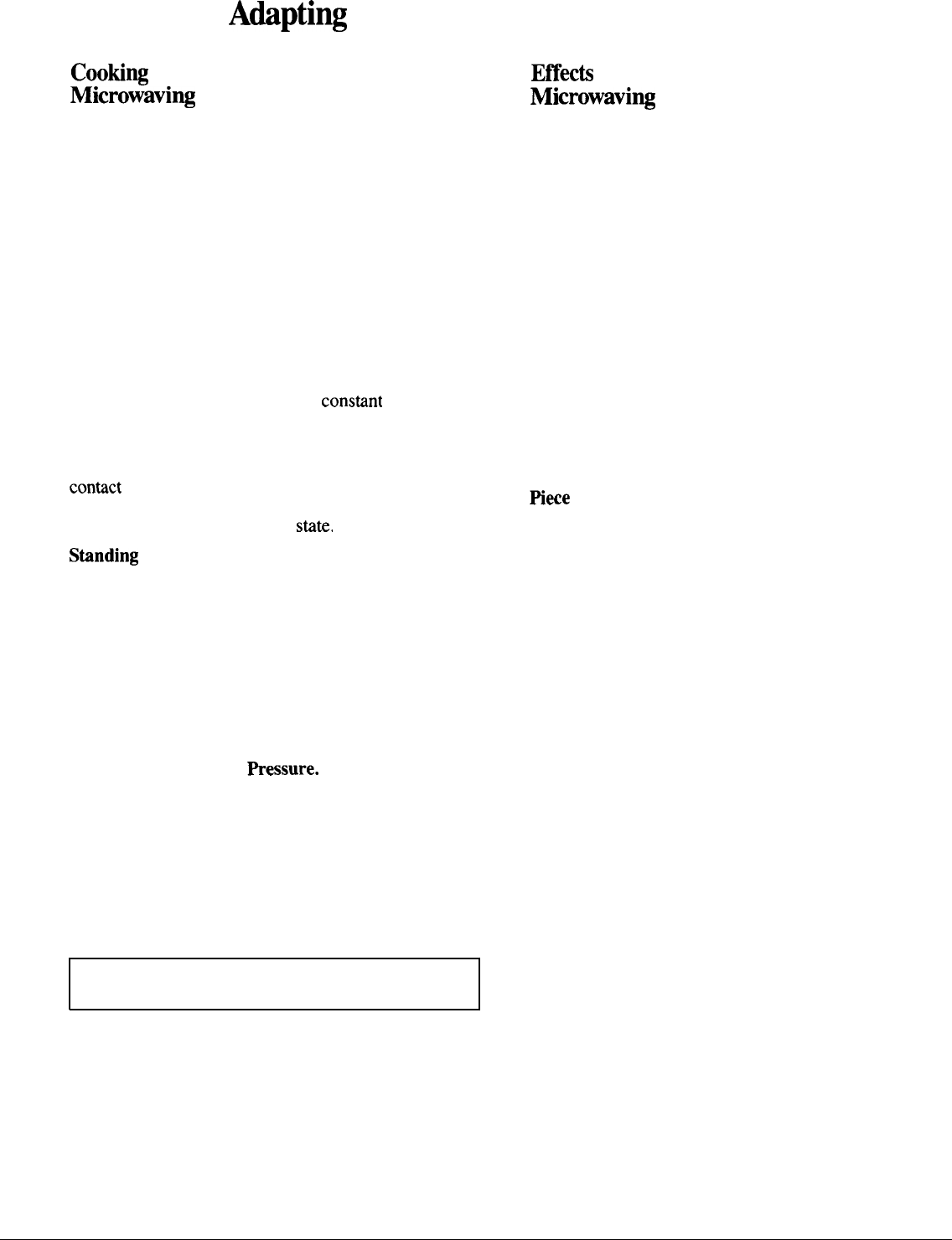
Microwave
A&pting
CootiW
Techniques for
Microwavi~
Covering.
In both conventional and microwave
cooking, covers hold in moisture and speed heating.
Conventionally, partial covering allows excess steam to
escape. Venting plastic wrap or covering with wax paper
serves the same purpose when microwaving.
Arranging Food in Oven.
In conventional baking, you
position foods, such as cake layers or potatoes, so that
hot air can flow around them. When microwaving, you
arrange foods in a ring, so that all sides are exposed to
microwave energy.
Stirring.
In range top cooking, you stir foods up from
the bottom to help them heat evenly. When
microwaving, you stir cooked portions from the outside
to the center. Foods which require
constint
stirring
conventionally will need only occasional stirring.
Turning Over.
In range top cooking, you turn over
foods such as hamburgers, so both sides can directly
contict
the hot pan. When microwaving, turning is often
needed during defrosting, or when cooking foods such
as hamburgers from the frozen
stite.
Stinding
Time.
In conventional cooking, foods such as
roasts or cakes are allowed to stand to finish cooking or
set. Standing time is especially important in microwave
cooking. Note that the microwaved cake is not placed on
a cooling rack.
Shielding.
In a conventional oven, you shield chicken
breasts or baked foods to prevent over-browning. When
defrosting, you use small strips of foil to shield thin
parts, such as the tips of wings and legs on poultry,
which would cook before larger parts were defrosted.
Prick Foods to Release
fiessure.
Steam builds up
pressure in foods which are tightly covered by a skin or
membrane. Prick potatoes (as you do conventionally),
egg yolks and chicken livers to prevent bursting.
Rotating.
Occasionally, repositioning a dish in the oven
helps food cook evenly. To rotate 1/2 turn, turn the dish
until the side which was to the back of the oven is to the
front. To rotate 1/4 turn, turn the dish until the side
which was to the back of the oven is to the side.
If you use a meat thermometer while cooking, make
sure it is safe for use in microwave ovens.
Effeck of Food Characteristics on
Microwavi~
Density of Food.
In both conventional and microwave
cooking, dense foods, such as a potato, take longer to
cook or heat than light, porous foods, such as a piece of
cake, bread or a roll.
Round Shapes.
Since microwaves penetrate foods to
about l-in. from top, bottom and sides, round shapes
and rings cook more evenly. Corners receive more
energy and may overcook. This may also happen when
cooking conventionally.
Delicacy.
Foods with a delicate texture such as custards
are best cooked at lower power settings to avoid
toughening.
Natural Moisture
of food affects how it cooks. Very
moist foods cook evenly because microwave energy is
attracted to water molecules. Food uneven in moisture
should be covered or allowed to stand so heat can
disperse evenly.
Piece
Size. Small pieces cook faster than large ones.
Pieces which are similar in size and shape cook more
evenly. With large pieces of food, reduce the power
setting for even cooking.
Shape of Food.
In both types of cooking, thin areas
cook faster than thick ones. This can be controlled in
microwaving by placing thick pieces near the outside
edge, and thin pieces in the center.
Starting Temperature.
Foods taken from the freezer or
refrigerator take longer to cook than foods at room
temperature. Timings in our recipes are based on the
temperatures at which you normally store the foods.
Quantity of Food.
In both types of cooking, small
amounts usually take less time than large ones. This is
most apparent in microwave cooking, where time is
directly related to the number of servings.
12


















